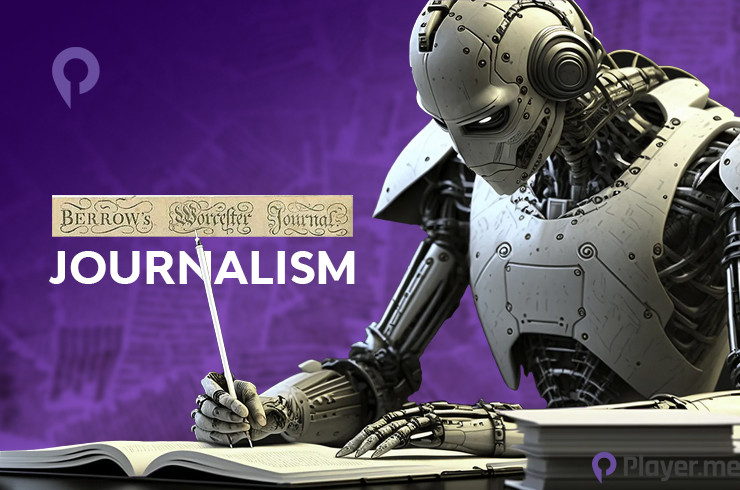Berrow’s Worcester Journal, tracing its roots back to 1690 and laying claim to being the oldest surviving newspaper globally, is at the forefront of a transformative shift in journalism. Owned by Newsquest, the UK’s second-biggest regional news publisher, Berrow’s Worcester Journal has joined the league of publications employing AI-assisted reporters to enhance their coverage.
Read More: 5 Best Craiyon AI Alternatives That Will Help You Create AI Art in 2024
AI Integration: Empowering Journalists at Newsquest for Enhanced News Reporting
Newsquest, responsible for over 200 titles, including renowned publications like the Glasgow Herald and the Brighton and Hove Argus, has strategically incorporated AI-driven journalism across its newsrooms. The move involves deploying AI-assisted reporters who utilise an in-house copywriting tool based on ChatGPT technology, a sophisticated chatbot drawing insights from web-text data.

Stephanie Preece, the editor of Worcester News, highlights the role of AI in streamlining mundane but essential tasks, such as converting local council meeting minutes into concise news reports. The innovative approach gives human reporters the freedom to focus on immersive tasks like attending events, interviewing key figures, and conducting in-depth investigations.
Despite the integration of AI, Preece emphasises that the technology doesn’t replace essential journalistic skills. AI can’t be present at the scene of an incident, navigate courtrooms, or engage with the community on a personal level. Instead, it complements human efforts, offering efficiency and enabling reporters to delve deeper into their storytelling.
Newsquest’s Journalist-Centric AI Tool Undergoes Stringent Editorial Oversight
Newsquest’s tool is designed to be journalist-centric, with trained professionals inputting information into the system. The content generated by AI undergoes rigorous editing and refinement by news editors, a process aimed at ensuring accuracy and credibility and steering clear of AI’s historical challenges with precision.
Newsquest’s CEO, Henry Faure Walker, underscores the invaluable role of AI-assisted reporters during critical events, citing an example from the Hexham Courant in Northumberland. The AI system proved instrumental when the town became a focal point of national news due to an incident involving the Sycamore Gap tree on Hadrian’s Wall.
Jody Doherty-Cove, Head of Editorial AI at Newsquest, acknowledges concerns about AI in journalism but assures that multiple safeguards are in place. Extensive training and adherence to a new code of conduct are part of Newsquest’s strategy to mitigate potential challenges.
A Little About Berrow’s Worcester Journal
Berrow’s Worcester Journal proudly stands as one of the longest continually published newspapers, drawing history enthusiasts, researchers, and curious minds alike to explore its rich archives. The repository holds a treasure trove of the newspaper’s legacy, with access to copies on microfilm dating back to 1712. Visitors can delve into the past through bound volumes spanning from 1712 to the mid-19th century, providing a captivating glimpse into the historical evolution of the newspaper.

The roots of the publication trace back to 1709, when Stephen Bryan initiated the printing of the Worcester Postman. Initially geared towards gentlemen seeking insights into London and global events, trade prospects, corn prices, and local advertisements, the focus gradually shifted to include more localised information. Despite contemporary expectations, early local newspapers featured limited local news, assuming that readers were already familiar with local events. The transition to a broader coverage approach accompanied the name change to Worcester Journal, leading to its renaming in 1753 as Berrow’s Worcester Journal, a name it proudly carries to this day.
During the first century, stamp duty on newspapers posed a significant financial burden for publishers. The abolition of this duty in 1855 ushered in a new era, encouraging the growth of the larger newspapers and the emergence of new titles. Berrow’s Worcester Journal navigated a landscape of competition, contending with rivals like the Worcester Herald, Worcestershire Chronicle, and Worcester Daily Times, each representing different political views. Notably, Berrow’s Worcester Journal embraced a conservative stance, setting it apart in the diverse tapestry of historical newspapers.
Navigating the Future: AI’s Inevitable Integration and the Resilience of Local Journalism
As AI-driven journalism gains momentum, Doherty-Cove predicts widespread acceptance in the future, paralleling the integration of the internet as a journalistic tool. He envisions a time when the term “AI-system reporter” becomes as commonplace as “Internet-assisted reporter” is today.
While larger media outlets are incorporating AI to streamline operations, the broader landscape of journalism faces challenges. Local reporters, already stretched thin and facing cuts, grapple with the evolving media landscape. The Charitable Journalism Project notes a decline in local newspapers, attributing it to factors such as advertising revenue declines.
In the face of such challenges, Berrow’s Worcester Journal and its contemporaries must adapt to survive. Preece underscores the importance of embracing change and staying attuned to the evolving world to ensure the continued relevance and impact of local journalism. As Berrow’s Worcester Journal navigates the changing landscape, the integration of AI emerges as a strategic move to fortify its position in the world of news reporting.
Author Profile
Latest entries
 GAMING2024.06.12Top 4 Female Tekken 8 Fighters to Obliterate Your Opponents in Style!
GAMING2024.06.12Top 4 Female Tekken 8 Fighters to Obliterate Your Opponents in Style! NEWS2024.03.18Elon Musk’s SpaceX Ventures into National Security to Empower Spy Satellite Network for U.S.
NEWS2024.03.18Elon Musk’s SpaceX Ventures into National Security to Empower Spy Satellite Network for U.S. GAMING2024.03.17PS Plus: 7 New Games for March and Beyond
GAMING2024.03.17PS Plus: 7 New Games for March and Beyond GAMING2024.03.17Last Epoch Necromancer Builds: All You Need To Know About It
GAMING2024.03.17Last Epoch Necromancer Builds: All You Need To Know About It





